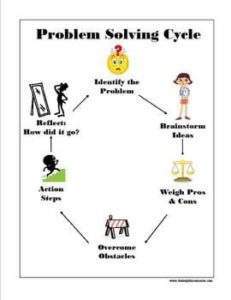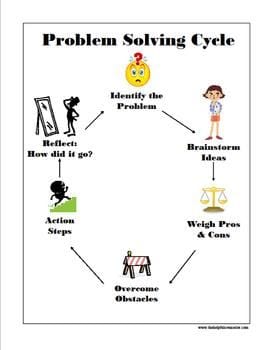Student Contributor: K. Hylton
 The problem solving cycle gives students the steps and procedures they need to take in order to solve a problem between them and another student. This tool allows for students to solve problems themselves without teacher interference (unless it is needed) and develops their skills of solving problem.
The problem solving cycle gives students the steps and procedures they need to take in order to solve a problem between them and another student. This tool allows for students to solve problems themselves without teacher interference (unless it is needed) and develops their skills of solving problem.
This tool would be taught to the students at the beginning of the year, and then a poster of the cycle would be put in the room to remind students of the cycle so they can use it when they have a conflict with another student. The cycle is identify the problem, brainstorm ideas, weigh pros and cons, overcome obstacles, action steps, and then to reflect on the whole situation. Each of these steps will allow for students to self-identify the problem, what they think is causing the problem, and steps that need to be taken in order to solve the problem. The teacher should only intervene in the situation if the students are unable to go through the cycle successfully by themselves. This process teaches students to rely on themselves to solve problems rather than just having the teacher solve the problem for them.
This tool is in the corrective phase because it is being used to correct the behaviors and problems between students. This cycle also restores the conflicts in hope of starting a better relationship between students. Students will use this tool to solve problems with a student, and then can use the same steps again when another problem arises with perhaps a different student. This tool is mostly student centered but can become collaborative because it is up to the students the first time through the cycle to try to take all the steps to solving the problems themselves. However, if the students unsuccessfully go through the cycle without coming to an agreement on how to solve the problem, the teacher will then help to complete cycle so the students are able to come to an agreement on how to solve the issue.
More Information –
Tool Source: Pinterest


